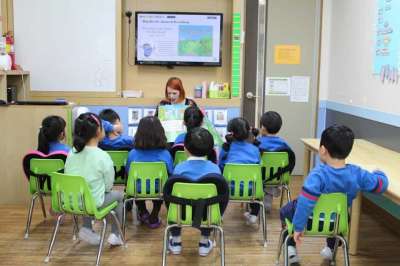Difficulties for Teachers Teaching South Korean Students

Before starting my TEFL course to gain a more professional basis, I worked as an English teacher in South Korea for about one year. In this short essay, I will explain some of the most prominent difficulties South Korean students seem to face when learning English.
This post was written by our TEFL certification graduate Laura M.
Education system
First and foremost, the educational structure in South Korea is quite different from those of Europe or the United States. Korean kids usually start studying English from the age of three. However, the average class size of about 40 students is way too big for such young students, making any interaction between teacher and student impossible. Later on, most Korean students become very exam-conscious. In order to get into a prestigious university, they have to get extremely good grades. The pressure resting on the student’s shoulders makes getting good grades their main goal, meaning that they don’t try to learn how to use the language but instead how to get the highest scores. This shows during class time. As oral exams are pretty much non-existent the focus lies on learning as much vocabulary as possible, even if they might not be able to use it. There are barely any conversation sessions included making it hard for students to actually use what they learned.

Also Read: Common Factors that Affect 1st Language and 2nd Language Learning
Differences in the phonetic systems of Korean and English
The huge difference between their native language and the english language reaches from the phonetic system over the syntactic structure to the semantics of the languages and poses another difficulty for English learners. Considering Phonetics, English letters can be pronounced in various ways, however, in the Korean language, each letter corresponds to exactly one sound unit which causes confusion when encountering the multiple sounds of English letters.
Furthermore, the pronunciation of various letters may cause problems. As some letters don’t exist in the Korean alphabet, such as ‘f’ or ‘v’, pronouncing them takes a lot of practice for beginners. The letters ‘l’ and ‘r’ are the same letter in Korean, making it difficult to distinguish and pronounce them. In Korean, a consonant is always followed by a vowel. This leads to most students adding non-existent vowels in between consonants that should follow one another directly. This is also the reason why “Wednesday” may become “wedeuneseuday”, putting the /eu/ pronunciation of the letter 으 in between consonants.

Also Read: The Many Roles of the Teacher in the ESL Classroom
Syntactic differences
Besides phonetic differences, there are also a few syntactic differences, that make switching between Korean and English difficult. The typical sentence structure in English is SVO; subject, verb, object, while in Korean it is SOV; subject, object, verb. This is one of the main causes why Korean students may need some time to put together their sentences in the correct order.
Adverbs are always put before the modified elements in Korean. So Koreans usually put adverbs at the beginning of a sentence or directly following the subject. And just as most learners of the English language, Koreans also struggle with the adding of -s in the third person singular.
Korean culture
Last but not least the influence of Korean culture on English classes should not be forgotten. Just as it is the case all over the world, culture also influences the thinking and behavior of students.
Koreans are usually very group-oriented in their thinking. This implies that they tend to keep a reserved attitude and not express themselves too much. They often use specific words to soften statements, like for example “somewhat” or “a little”. The importance of family in Korean culture also leads to students using “our” instead of “my”. Referring to one’s parents or teacher as “my parents” or “my teacher” would be very impolite in Korean. It is important to teach them, that it is not considered impolite in English but only gives information about the relationship between the two actors. This is also the case for the usage of names. Instead of using names people are referred to by their social status or family role. This is also the reason why most students don’t call their teacher as “Mr. XXX” but instead simply call out “teacher”. Cultural differences can also lead to the switching of order in idiomatic phrases. As this can be very confusing to students it is crucial to explain why these differences exist. Koreans would, for example, say “east, west, south, and north” instead of “north, south, east and west” because they oriented themselves via the sun that rises in the east, unlike most western people who take the north pole as a point of orientation.

One should also keep in mind that cultural differences can shape the way students behave. For example, Korean students might avoid eye contact. While that could be considered rude in most western countries, it is a sign of respect in Korea. Students can also easily be seen blushing or being embarrassed after being praised since they are not used to praise from most of their Korean teachers because they try to keep up the student’s humility and self-criticism. Overall the fear of making mistakes seems to be a pretty big problem. Most students would rather just giggle or look away scared instead of admitting they didn’t understand the question and not answer at all instead of making mistakes. Usually, answers in group discussions become repetitive very fast and students mostly only give answers the teacher might want to hear in order not to stand out.
Also Read: The TEFL Budget Planner: How much money do I need to teach English abroad?
Do you want to teach English in South-Korea?
Even if one might not be able to change these deeply ingrained habits it is important for teachers to understand where they come from and what they mean. This way misunderstandings can be prevented and a better classroom atmosphere can be achieved. Speaking Korean myself has really helped me understand where the difficulties for most Korean students lie. Simply getting to know the structure of their language can be a huge advantage in understanding them better. I consider it part of a teachers job to not only teach but also learn from one’s students.
Apply now & get certified to teach english abroad!
Speak with an ITTT advisor today to put together your personal plan for teaching English abroad!
Send us an email or call us toll-free at 1-800-490-0531 to speak with an ITTT advisor today.
Related Articles:
- How do I get a job teaching English in South Korea
- 10 Questions You Need to Ask Before Enrolling In a TEFL Course
- The 10 Best Destinations for Teaching English Abroad in 2018
- Online or In-Class - Which TEFL Course Should You Take?
- The Best Government Programs For Teaching English Abroad
- What Scams to Look Out for When Looking for TEFL Jobs



